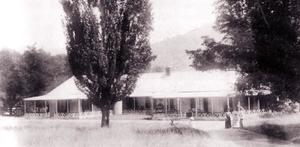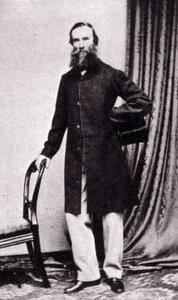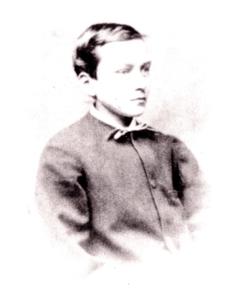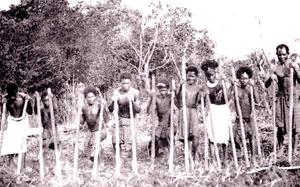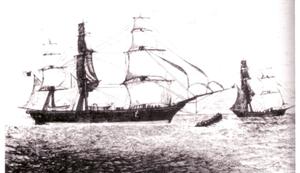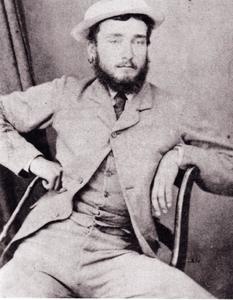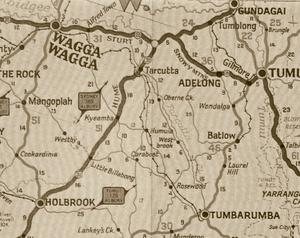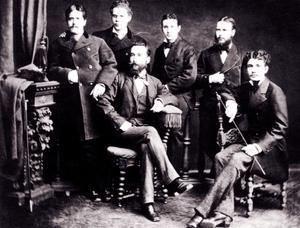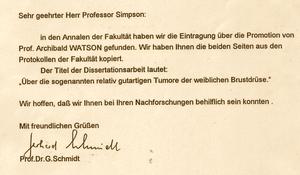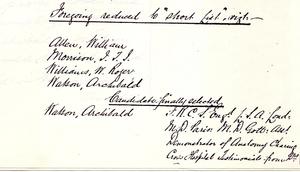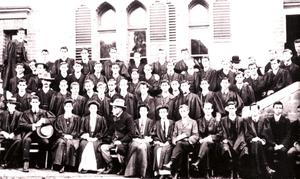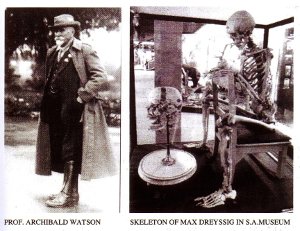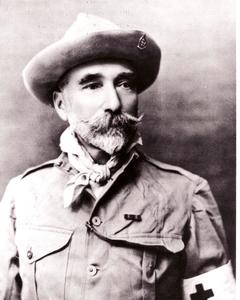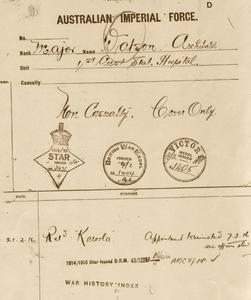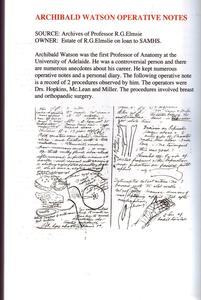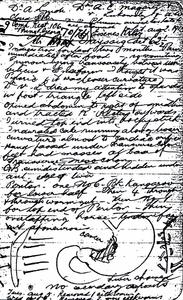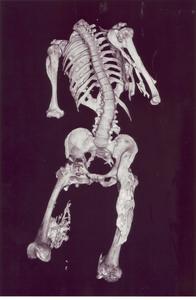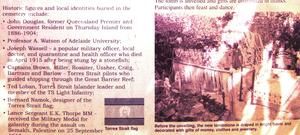
South Australian Medical Heritage Society Inc
Website for the Virtual Museum
Home
Coming meetings
Past meetings
About the Society
Main Galleries
Medicine
Surgery
Anaesthesia
X-rays
Hospitals,other organisations
Individuals of note
Small Galleries
Ethnic medicine
- Aboriginal
- Chinese
- Mediterran
ARCHIBALD WATSON, 1849-1940. ELDER PROFESSOR OF ANATOMY. UNIVERSITY OF ADELAIDE.
Archibald Watson was born in Tarcutta in 1849. His father Sidney Grandison Watson was a pioneer settler often referred to as "The King of the Upper Murray". Archibald had three sisters and was the eldest of his three brothers. His early education was at Scotch College in Melbourne and there is a report from his Master calling him an excellent student.
Watson's father was involved in several land ventures and travelled to Fiji to purchase some property there in 1869. When Archibald returned from Melbourne it is quite likely that his father dispatched him to Fiji to gain overseas experience and to report on his properties. This is the beginning of a controversial part of his life. There was a need of manpower in the Australian cane-fields and cotton fields elsewhere. Many entrepreneurs were trying to provide a labour force for these enterprises. The methods were suspect and neared the definition of slavery, a common appellation used was "blackbirding". Archibald Watson arrived there in 1871 and joined a brig called Carl, owned by Dr. Murray, a Melbourne GP. In the previous voyage the Carl and its captain were involved in an incident which involved violent death of several natives. The British sent a naval force to apprehend the culprits.
The crew and captain Anderson were jailed. Watson, because of his age and considerable support from local authorities and lawyers, (Scutters and Truscott) has been released to face further investigation in Australia for a bail fee of ~$1000 ( £200 ).
There is no doubt that Watson had been advised by many people, and decided not to await the verdict of the government inquiry, instead he sailed to Europe via North America. His decision to study medicine could have been influenced by his mother's death. The cause of death was recorded as a ruptured ectopic pregnancy. It is also possible that Murray had some influence. It is of interest that his first doctorate in medicine was from Gottingen (1878). It confirms Watson's linguistic abilities.
In 1880 Watson was in Paris and obtained another doctorate. The theme was dealing with complications of inguinal hernias. In order to obtain his English (and Australian ) credentials he moved to London. Here he passed the English degrees: LSA, the MRCS and FRCS. He also instructed in Anatomy at the Charing Cross Hospital. In France, Germany, and in England, he met and spoke to the medical doyens of that time. It is said that he had a record of their vignettes. Lister, Hutchison, Charcot and others have been quoted.
When an advertisement for the Chair of Anatomy in Adelaide appeared in Lancet, the Athenaeum and other elite editions, Watson applied.
Of the 22 applicants there was a short list of four, and Watson was a unanimous winner. Dr. Edward Stirling came from Adelaide and was one of the selectors. Watson's references from Germany, France and England were impeccable.
Watson's appointment was announced in 1885 and he and Stirling returned to Adelaide.
They were met by Thomas Elder (later Sir), who provided the funding for the chair, and
Watson's 34 year tenure as Professor of Anatomy (1885 – 1919) had began.
He was a charismatic personality. His past and present publications (hydatid disease,
neurofibromatosis, myositis-ossificans and war injuries (Boer and WW1) ), as well as his
past French and German papers would not be large by today's standard, yet his personality
and tenure has been discussed and reported by many notable surgeons and historians.
He has been remembered in the Royal Australasian College of Surgeon's Archibald Watson
Memorial Lectures and in numerous publications about his tenure and his life.
His diaries, illustrations detailing of operative procedures and day events are probably
the only unique and fully personal record of such type.
The following represent some of the diary entries and photographs from the publications
and collections stored by numerous national libraries and the Royal Australasian College
of Surgeons.
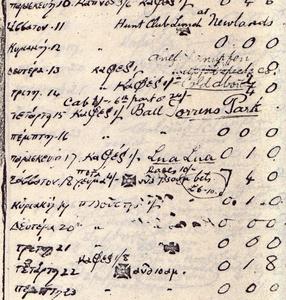
A PAGE FROM WATSON'S DIARY: THE DAYS OF THE WEEK ARE IN GREEK, THE ENTRIES ARE MOSTLY IN ENGLISH APART FROM THE GREEK WORD FOR BREAKFAST. THERE IS ALSO A FIJIAN WORD "LUA LUA" (17th). THE CROSSES AND OTHER MARKS, SUCH AS CIRCLES AND TICKS HAVE HAD SEVERAL INTERPRETATIONS.
| Wednesday 15th | "Caught a cab to a ball at Torrens Park – 6 people in the cab, paid 1/6 of 24 s” [possibly] |
| Friday 17th | coffee |
| Saturday 18th | lunch |
Watson was 70 when he retired from Adelaide University. His father's estates made him financially secure and he travelled widely. One hobby among others was fishing and there are several photographs of him with his catches. He rode his motorcycle in his eighties. He also had a comprehensive collection of fishing lures. His last years were spent on Thursday Island. Again his personality, risque remarks and demonstration of a beating shark's heart in pail of water are remembered.
He was admired, and loved by his friends but he also was ostracised by some others in the medical profession who occasionally found his actions and forthright comments difficult to tolerate. The Royal Australasian College of Surgeons established a series of Memorial Lectures about him. The first was given by Sir Henry Simpson Newland and others who followed traced his life in Australia, Germany, France, and England.
Acknowledgments:
Professor Simpson made frequent references about him in his Medical Doctorate Thesis from the
University of Adelaide "The Adelaide Medical School, 1885-1914, A Study of Anglo-Australian
Synergies in Medical Education."
Professor R. G. Elmslie studied his life and wrote about the dispute concerning Dr. A. D. L. Napier and Professor Watson in 1896: "Mrs. L's case, A celebrated South Australian surgical case." (Aust N Z J. Surg 1991 61- 780-788). He and Sue Nance also wrote about him in the Journal of Australian Biographies (vol. 12, 1891-1939, Smy-Z, pp 394-396). Professor Elmslie collected numerous photographs of Watson and has copied his diaries and operative notes. These are now stored with The Queen Elizabeth Historical Society and provided most of the above material.
Dr. P. W. Allen wrote a paper about Watson titled "Adelaide Blackbirding Pathologist" (Ann Diagn Pathol 1988 Jun 2 (3) 208-11).
Jennifer M. T. Carter published a most concise and referenced record of Archibald Watson's history: "Painting the Islands Vermillion Archibald Watson and the brig Carl." Melbourne University Press, 1999.
All of the above were a valuable sources of information.
-o0o-
